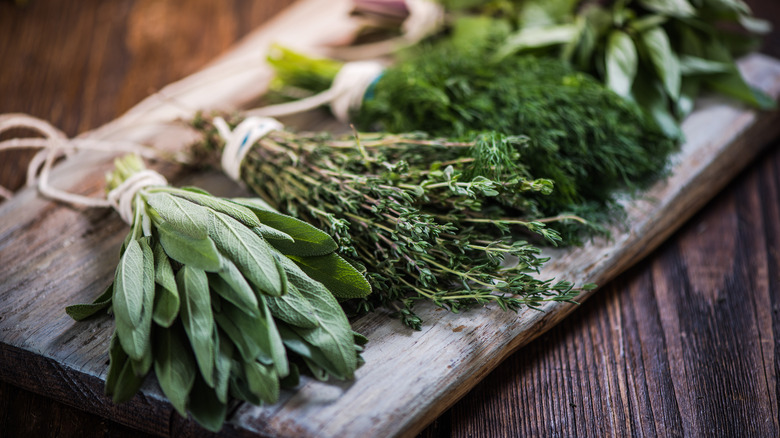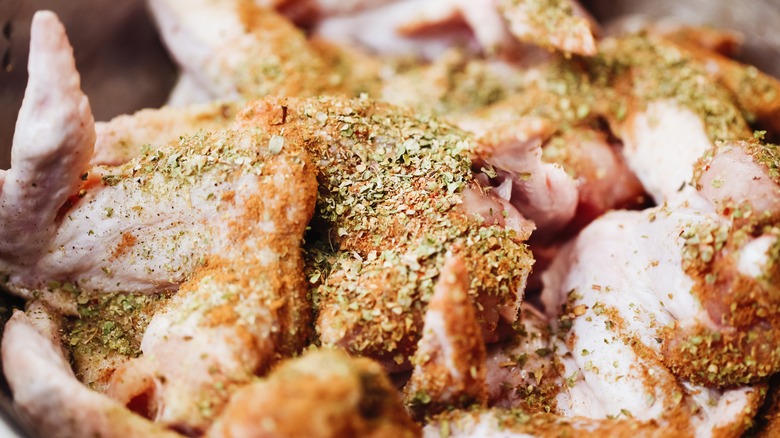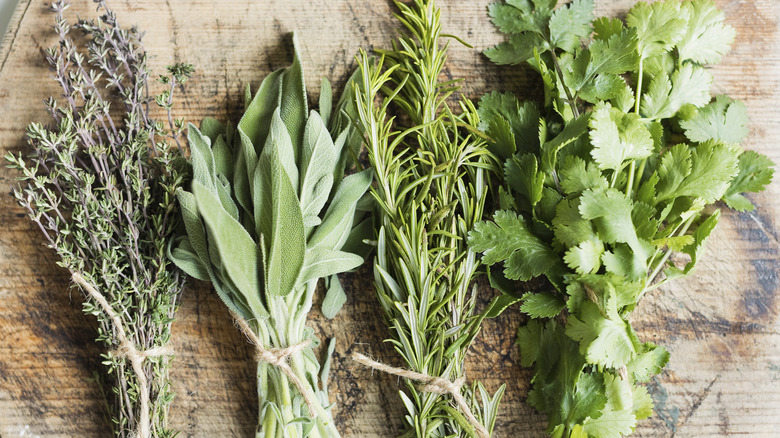What's Best For Drying Your Herbs? The Oven, Microwave, Or Dehydrator?
Fresh herbs are among the most popular edible plants to grow at home. They're fairly easy to raise even in small spaces, and there's nothing like chopping up a bunch of basil to sprinkle over tomatoes or garnishing steaks with fresh rosemary. Whether grown from seeds or purchased as a bunch at the grocery store, fresh herbs share one thing in common: Generally there's a lot left over, and the sensitive plants go bad within a few days. While there are ways to keep mint and other herbs fresh longer, there's an even better approach to making the most of their abundance: Drying them while they're still good. It's easy to do, and will save money compared to buying jars of expensive dried oregano and sage.
There are several methods for drying herbs, all completely accessible to the home gardener and chef, including your microwave, which is probably the best option for most people. Some work better than others — dehydrators preserve the most flavor, while microwaves are nearly effortless and work the fastest. In most cases, ovens are a no-go. As long as you're not planning to go into farmer's market-level production, these home solutions work well, so it's worth exploring the pros and cons of each.
The best techniques for drying herbs
Drying herbs doesn't just extended shelf life. You're also safely preserving some of the herbs' original flavor, color, oils, and nutrients. Air drying by hanging inverted bunches of sprigs is the traditional method and ideal for large quantities, but takes a week or two and is fraught with pitfalls: humidity, dust, active children or pets. So, let's focus on the two best methods.
The best route for most people is the humble microwave oven. Place a single layer of herbs between paper towels and microwave on high for 1 minute. Then stir and heat every 30 seconds until almost dry (between 2 and 6 minutes, depending on your oven's wattage). Finish air drying at room temperature then spread across a baking tray or cutting board. This method works best with broadleaf herbs like basil and cilantro.
If the goal is maximum preservation of color and flavor, dehydrators are best. Make sure stems or individual large leaves don't touch where possible. Set to about 100 degrees Fahrenheit, and dry 1 to 3 hours. Avoid drying with other fruits or vegetables, as the flavors of each item can impact others. Here you want the herbs to dry out completely until they crumble.
No matter the method, make sure the herbs and workstation you are using are clean, and wash your hands. Remove any blackened leaves or stems, and inspect for bugs (especially with recently harvested herbs). Shake off excess moisture and pat dry with a paper towel.
Why you shouldn't use an oven to dry herbs
Though it might seem like a no-brainer to dry herbs out on a baking sheet in the oven, it's generally not recommended. The challenge is that most home ovens can't heat at very low temperatures. Because most home ovens run too hot for this task, it's too easy to singe the leaves. If you decide to give it a try, set the oven to its lowest temperature (below 180 degrees Fahrenheit). Prop the door open a bit (best with electric ovens) and check frequently. Place sprigs with smaller or more fragile leaves, like dill, on metal racks over pans to increase air circulation. Cook for 3 to 4 hours, and monitor closely.
Once herbs are fully dried (they should crumble easily), bottle them tightly in clean jars or tins. Store in a dry, dark cupboard or pantry, and you have your own seasonings on hand to sprinkle over everything from squash or pizza to watermelon and mozzarella Caprese salad. The best thing about this approach is that it works whether you have one sprig of fresh herb left over, or a hundred.


